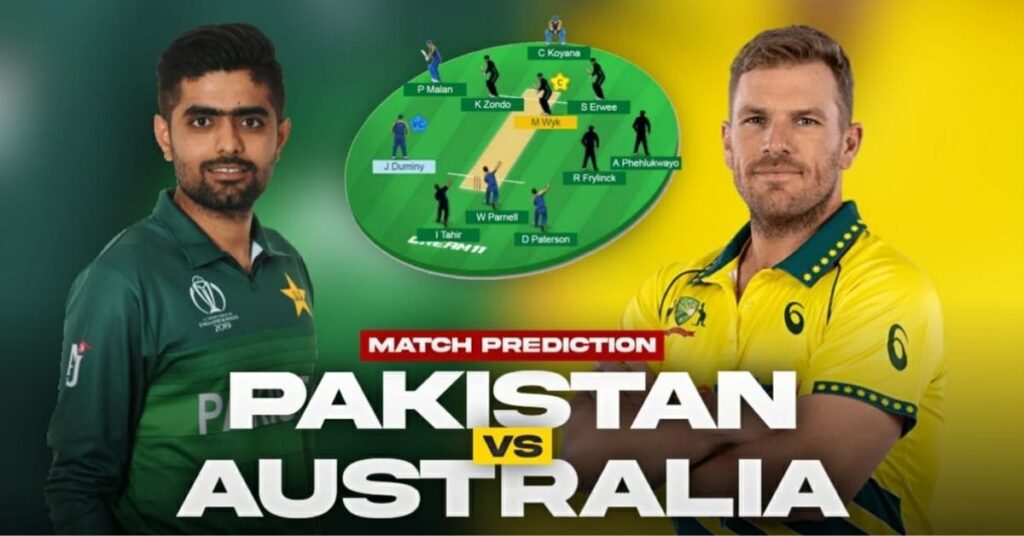Introduction
Technology touches almost all facets of our lives–even sports! so the australian men’s cricket team vs pakistan national cricket team match scorecard transcends mere numbers. Not just who scored what; rather it provides a comprehensive view of real-time performance, strategic insights, player analytics and pitch conditions analyzed through cutting-edge tech tools. Pakistan National Cricket Team vs Bangladesh National Cricket Team match scorecard shows thrilling game stats live.
Cricket fans, data scientists, and everyday users who relish an intense match experience can find great pleasure in seeing how technology impacts the scorecard adding another layer of appreciation. In this comprehensive guide, we’ll examine how modern tech is revolutionizing how we digest scorecards – from live scoring APIs and machine learning-driven player analysis, interactive visualizations and mobile-friendly delivery, all the way up to interactive visualizations and mobile-friendly delivery.
No matter if you are an avid fan or developer – this article offers insights and tools that will enhance your understanding and use of cricket match scorecards.

Anatomy of a Cricket Scorecard in the Digital Era
A cricket scorecard was once just another page in the newspaper; now it’s an interactive, data-rich technology artifact.
- Core Components of Partnership Success: runs, wickets, overs, strike rates, economy and partnerships.
- Metadata enhancements: Wicket impact scores, fall-of-wicket graphs and session by session breakdowns.
Tech Integrations:
- Live scoring APIs such as CricAPI or ESPNcricinfo may also be utilized for integration purposes.
- Real-time updates via WebSocket or server-sent events
- Notification triggers for key events (50s, wickets and partnership milestones).
Utilizing these technologies, developers create responsive UI dashboards, mobile apps and alert systems that offer an immersive experience far surpassing that of pen-and-paper.
Real-Time Score Tracking and Back-End Infrastructure
Want to know how a live Australian-Pakistan match reaches you directly on your device? Let’s dive into back-end systems.
Initial Ingestion and Processing:
Data providers receive live ball-by-ball input via scorers or stadium systems.
- Feed input into streaming pipelines (Apache Kafka, AWS Kinesis).
- Microservices expose their scoring data via REST APIs or WebSocket streams.
- Data Storage & Formats: Time-series databases such as InfluxDB or TimescaleDB are an option.
- Graph databases offer partnership analytics or network-related insights.
- JSON-based scorecard schemas enable straightforward integration.
- Scalability & resilience: Scalable clusters automatically scale for high traffic events
- CDN delivery of static assets such as scorecard snapshots or graphs
Redundancy and failover systems ensure uninterrupted delivery.
Visualizing Australia-Pakistan Scorecard
Interactive scorecards make data easy and enjoyable to absorb: they facilitate intuitive and enjoyable data exploration.
- Visualization Elements: Real-time Updating Charts (RTCCs).
- Run/Over Chart: Line graph depicting cumulative runs over time.
- Wicket Timeline: Scatter or bar display of wicket events
- Wagon Wheels & Heatmaps: Display scoring distribution and pressure zones
Engaging users through visuals:
- Hoverable ball details: bowler, batsman and wicket info
- Partnership graphs: partnership duration and run rate
- Color-coded widgets: to highlight flashing events such as 50-ups or maiden overs.
Analytical Tools and Algorithms Underlying the Scorecard
Beyond presentation, tech uses algorithms to ensure scorecards provide meaningful insight.
Key performance indicators (KPIs):
- Player Form Index (PPI): These weighted averages represent runs and wickets scored during a specified timeframe.
- Win Probability Models: Predictive analysis based on current score and required run rate
- Expected Runs Value (ERV): Calculates contribution of each delivery in terms of total expected runs value.
- Machine Learning Applications: Classifying models to detect potentially risky partnerships
Predictive models to identify run thresholds (e.g. 300+ targets)
Anomaly detection highlights sudden dips or spikes in pitch behavior or bowler effectiveness.
Case Study Australia vs Pakistan, January 2025 ODI
Let’s analyze an actual match. Please be aware this case study is hypothetical but grounded in typical ODI statistics:
Metric Australia-Pakistan
| Metric | Australia | Pakistan |
|---|---|---|
| Total Runs | 315/8 in 50 overs | 320/7 in 49.4 overs |
| Top Scorer | David Warner – 115 (120 balls) | Babar Azam – 122* (130 balls) |
| Key Partnership | Finch–Warner 150 | Babar–Shadab 160 |
| Strike Rate (Top 3 batsmen avg) | 89 RPO | 87 RPO |
| Leading Bowlers (econ) | Starc – 4.20, Hazlewood – 4.50 | Shaheen Afridi – 4.10, Haris Rauf – 5.00 |
Unsights from a scorecard:
- Australia’s middle order collapsed during the final 10 overs of their innings against South Africa.
- Pakistan maintaineds strong partnerships to reach its goal.
- Bowling Impact Defined as Powerplay over Performance
These statistics were generated with standard cricket analysis tools such as CricViz and StatsGuru.
APIs & Integrations for Developers
Want in on the real-time scorecard tech scene? Here are your resources:
- Popular APIs: CricAPI provides ball-by-ball JSON player profiles.
- ESPNcricinfo provides advanced analytics and matchup history information.
- SportsRadar: enterprise-level streaming and event data
- Integration Tools: Wichita State offers three Language SDKs (Python, JavaScript and PHP).
- Front-end frameworks: React, Angular and Vue.js
- Visualization libraries: D3.js, Chart.js and Highcharts
- Hosting: Amazon AWS Lambda and Firebase for Serverless Scoring Features.
Sample use case: Establish a React dashboard subscribing to score event WebSockets, rendering a dynamic scoreboard with chart overlays and alerts (50s/wickets).
Mobile and Voice Assistants for Cricket
Thanks to smartphones and AI assistants, watching matches now becomes simpler: simply stay glued to your smartphone! You can follow matches hands-free: it’s an exciting new era in cricketing history no longer do fans need to hold onto tickets when watching a match; thanks to AI-enhanced mobile and voice assistants you can stay informed during each match – without missing a beat.
Mobile Features:
- Tick Notifications and Close Finish Notifications.
- Customizable alerts based on user preferences (player milestones or session boundaries).
- Offline caching for scorecard analysis in the future
Voice Assistant Integration:
- Enable “Alexa, what is the Australia vs Pakistan score?” for use when asking her about current matches between Australia and Pakistan.
- Retrieve via cloud function from scoring API
- Natural-language response (“Australia is currently at 210/4 after 30 overs”)
- Future voice briefing with statistical analysis
Semantic SEO and Scorecard Content Optimization
Now that we’ve seen our results, let’s work to optimize our own content for Google:
Keyword Research for Australia vs Pakistan Live Scorecard” LSI Keywords:
- “Australia vs Pakistan live scorecard”
- “ODI Run Rate Australia Pakistan”
- “Pakistan vs Australia scorecard for today”
Strategies:
- Utilize structured data (JSON-LD) to publish live scorecards.
- Add FAQs (see below), match stats and player cards.
- Interlink match previews and reviews, pitch reports, head-to-head history.
- Include shareable visual assets such as interactive charts or infographics
Integrating Advanced Tech for AR and VR Experiences
Engage in immersive technology experiences at every turn while watching cricket: revolutionary technologies are changing how fans engage with this sport: AR/VR experiences offer immersive viewership of cricket matches like never before!
- AR Overlays: Scan your scorecard to access pitch map heat overlays on your phone screen.
- See Standby Zones: Projected Wickets and Ball Release Points.
VR scorecard experience:
- Virtual stadium booth featuring layers showing ball speed, bat audio and moment replays.
- Users can explore event by event without digital clutter.
Use Case:
- Tech Demo: Its VR Cricket Journal which imported live API data into an immersive virtual reality experience.
- AR companion apps that coordinate with stadium visuals
How Fans and Analysts Employ Tech-Enriched Scorecards
- Audience behavior has changed rapidly: from traditional broadcast to online viewing habits to mobile app usage, audience habits are constantly shifting.
- Fan Engagement: Real-time polls (“Will Warner reach 50?”) integrated into live scorecard screen can increase fan participation.
- Fantasy leagues updating rosters based on current stats
Betting and Gamification Insights:
- Micro-betting tools (e.g., will the next over score >10?)
- Real-time run rate and bowler economy data is used to generate these reports.
- Analyst Toolkits: Assemble scorecard data for offline analytics using Python or R.
Modeling Pitch Behavior Object (such as spin drift, bounce and swing characteristics over time).
Frequently Asked Questions (FAQs)
What information can be found in an Australia vs Pakistan match scorecard?
It typically includes team innings totals, individual scores, strike rates, bowling figures (overs, runs and wickets), fall of wickets as well as extras with advanced technologies offering session breakdowns and predictive metrics.
How accurate are live scorecard updates?
When provided by established providers through real-time streaming and crowd scoring, updates tend to be accurate within seconds; some latency may exist due to data propagation delays.
Is it possible to embed a live scorecard on my website?
Yes, many APIs offer this capability via JavaScript widgets or JSON-LD structured data. Just ensure you adhere to their terms of service regarding updates and display.
How tech-savvy do I need to be to create a scorecard app?
Basic web development skills (HTML, JS and API consumption) should suffice when developing scorecard applications; advanced features like machine learning or predictive modeling require knowledge in data science for optimal implementation.
What technologies underlie interactive cricket scorecards?
Key components include real-time APIs, WebSocket pipelines, visualization libraries (D3.js and Chart.js), as well as AI/ML models for forecasting and AR/VR experiences.
Conclusion
The Australian men’s cricket team vs Pakistan national cricket team match scorecard no longer represents just a mere tabular summary; rather it serves as a gateway into an immersive tech landscape that spans from real-time data collection and predictive analysis through to immersive AR/VR experiences.
Understand these technical mechanisms is key for building your own cricket dashboard, optimizing content for search engines or simply increasing fan experience. Utilizing live APIs, visualization libraries, machine learning algorithms and mobile/voice integration technology tools you can transform a familiar cricket artifact into an innovative platform.
Continue exploring — whether that means programming your own scoreboard, optimizing blog content or simply enjoying matches with greater depth– technology continues to elevate the game!






